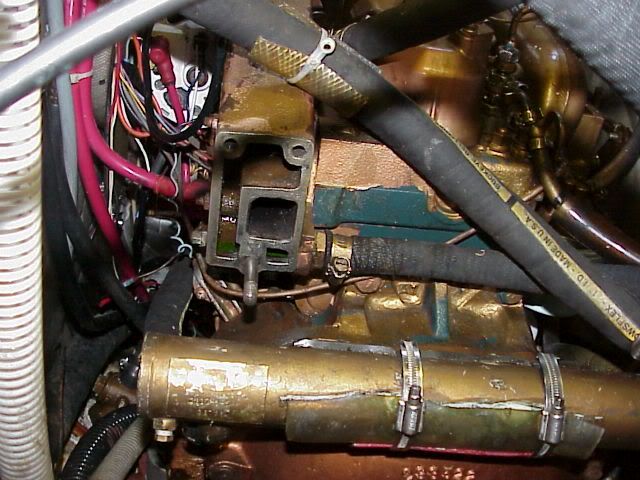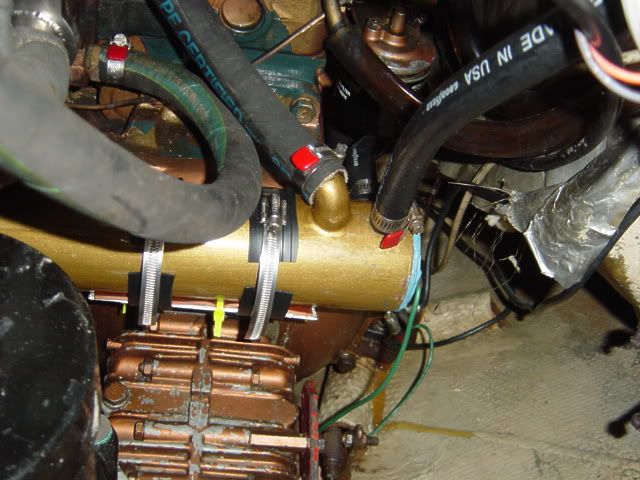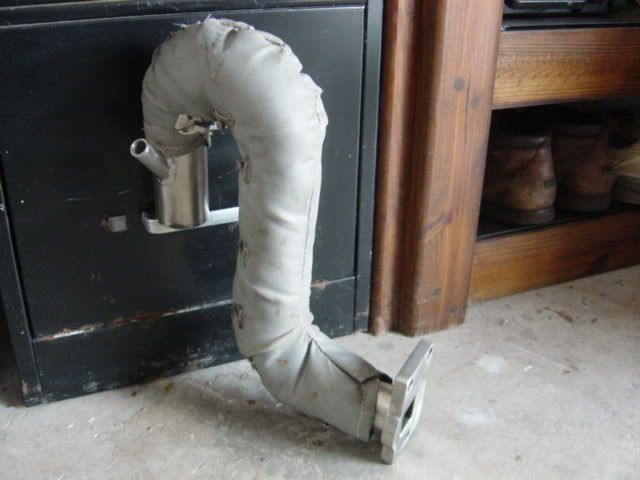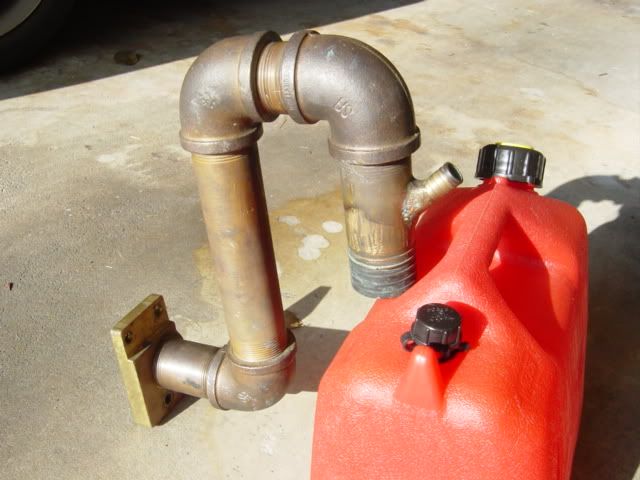Check your exhaust system
Moderator: Jim Walsh
- M. R. Bober
- Posts: 1122
- Joined: Feb 6th, '05, 08:59
- Location: CARETAKER CD28 Flybridge Trawler
Check your exhaust system
I took RESPITE out for a few days of fall single handing. As these things happen, there was virtually no wind for three days. While motoring home, the aroma of diesel exhaust wafted around the cockpit. Within a few seconds the air was lousy with smoke, steam, and stink.
So I found myself about 5nm from home with no wind and no safe way to run the engine and about one hour of daylight. Fortunately the crew of MAGGIE ROSE (CD33) answered the phone and came out to tow me to their dock. We are in a rural area and depend upon good friends.
The next morning I examined the engine room. Soot everywhere. I found the threaded pipe that connects the heat exchanger discharge to the exhaust manifold elbow had broken at the threads (the weakest point). When I began to effect repairs, I removed all of the fiberglass insulation from the exhaust system and put a pipe wrench on the elbow. With the first gentle tug the elbow gave way. Nothing but rust;all hidden under the insulation.
The insulation was strongly--make that forcefully--recommended by an excellent surveyor a few years ago to prevent engine room fires. It is hard to remove, but it hides potentially life threatening defects. You should remove the insulation and inspect the complete exhaust system regularly. I will be.
Mitchell Bober
Sunny Lancaster (home of the good ship MAGGIE ROSE), VA
So I found myself about 5nm from home with no wind and no safe way to run the engine and about one hour of daylight. Fortunately the crew of MAGGIE ROSE (CD33) answered the phone and came out to tow me to their dock. We are in a rural area and depend upon good friends.
The next morning I examined the engine room. Soot everywhere. I found the threaded pipe that connects the heat exchanger discharge to the exhaust manifold elbow had broken at the threads (the weakest point). When I began to effect repairs, I removed all of the fiberglass insulation from the exhaust system and put a pipe wrench on the elbow. With the first gentle tug the elbow gave way. Nothing but rust;all hidden under the insulation.
The insulation was strongly--make that forcefully--recommended by an excellent surveyor a few years ago to prevent engine room fires. It is hard to remove, but it hides potentially life threatening defects. You should remove the insulation and inspect the complete exhaust system regularly. I will be.
Mitchell Bober
Sunny Lancaster (home of the good ship MAGGIE ROSE), VA
CDSOA Founding Member
Mitchell,
Got that tee shirt. It happened to us in the middle of no where while enroute to the FL Keys. We were able to patch ours together long enough to get the hooks down in Marathon. We used a couple of tin cans and some hose clamps. Whatever you do DO NOT USE STAINLESS STEEL PIPE. It will crack. You may already know, but for steel pipe ABYC recommends a minimum schedule 80 pipe. But if you look at the MacMaster catalog, they carry much thicker pipe in both galvanized and black along with forged fittings. The best I remember the thickest is about a 1/4 inch wall thickness. The stuff is not cheap but worth it IMHO. Plus it appears to be better quality than the stuff from Lowes and Home Depot. I don't know what yours looks like, but ours is a plumbers nightmare and the castings of the elbows and street els from Lowes looks pretty poor in comparison. I compare it to the anchor shackles made in China versus those made in the USA.
As far as the wrap, we secure ours with hose clamps instead of wire, so it is easier to remove, and we now remove it and inspect the pipe annually when the water pump impeller is replaced. Oh by the way, the wrap is a lot cheaper at Advanced Auto Parts. They sell big rolls of it in the hi performance section where they have the headers and the like. Lot cheaper than through a marine retailer.
Well enough of my soapbox. Good luck with it. I know it is a pain in the backside.
Got that tee shirt. It happened to us in the middle of no where while enroute to the FL Keys. We were able to patch ours together long enough to get the hooks down in Marathon. We used a couple of tin cans and some hose clamps. Whatever you do DO NOT USE STAINLESS STEEL PIPE. It will crack. You may already know, but for steel pipe ABYC recommends a minimum schedule 80 pipe. But if you look at the MacMaster catalog, they carry much thicker pipe in both galvanized and black along with forged fittings. The best I remember the thickest is about a 1/4 inch wall thickness. The stuff is not cheap but worth it IMHO. Plus it appears to be better quality than the stuff from Lowes and Home Depot. I don't know what yours looks like, but ours is a plumbers nightmare and the castings of the elbows and street els from Lowes looks pretty poor in comparison. I compare it to the anchor shackles made in China versus those made in the USA.
As far as the wrap, we secure ours with hose clamps instead of wire, so it is easier to remove, and we now remove it and inspect the pipe annually when the water pump impeller is replaced. Oh by the way, the wrap is a lot cheaper at Advanced Auto Parts. They sell big rolls of it in the hi performance section where they have the headers and the like. Lot cheaper than through a marine retailer.
Well enough of my soapbox. Good luck with it. I know it is a pain in the backside.
Lee
S/V Solomon Lee
S/V Solomon Lee
-
Kurt
- Posts: 188
- Joined: Feb 8th, '05, 11:12
- Location: 27' Cape Dory (Alerion),
9' Dyer,
Grosse Pointe, Michigan
Do not used galvanized pipe for exhaust
FYI...do not use galvanized pipe for exhaust plumbing. The heat will cause the zinc coating to give off toxic fumes.
- Zeida
- Posts: 600
- Joined: May 27th, '05, 07:10
- Location: 1982 CD33 "Bandolera II" Hull #73Key Biscayne-Miami, Florida
- Contact:
Heat Exchanger problems
Mitch...
Since I also have Hull 76, CD-33, I assume I must have a very similar heat exchanger system such as yours. However, I do not totally understand your explanation of what happened to you, and am extremely interested in knowing exactly what part of your heat exchanger that failed.
you quote:
"the threaded pipe that connects the heat exchanger discharge to the exhaust manifold elbow had broken at the threads (the weakest point). When I began to effect repairs, I removed all of the fiberglass insulation from the exhaust system and put a pipe wrench on the elbow. With the first gentle tug the elbow gave way. Nothing but rust;all hidden under the insulation."
My heat exchanger does not have a threaded pipe: it connects via a hose to a RISER, which in turn, connects to the manifold. This riser -mine is all SS- does have a small elbow, welded into it, that receives the hose that comes directly from the heat exchanger. The RISER is the unit, in my case, that has a fiberglass wrap or insulation. Mine is held together with wire, but I can remove this wire easily for inspection. Every six or seven months I remove the hose that discharges into this little elbow, and make sure there is no soot or anything else clogging it. Is this what happened to you?
A couple of years ago I made a backup RISER, made of several all bronze fittings, which I used for a while, while my SS one had to be rewelded, since it had developed a couple tiny holes, precisely in that little elbow that receives the hose from the heat exchanger. But as soon as I got the SS back, I switched back to it, because it is a lot lighter and easier to work with than the all bronze one, which is very heavy.
Since I upgraded my heat exchanger from the original that came with the boat, a 2" diameter rather small heat exchanger, for a bigger 3" diameter heat exchanger, and replaced all hoses, clamps, etc. I am always very concerned about my exhaust system. My engine used to overheat if I pushed it above 22 rpm's, but after I switched to the bigger heat exchanger, it does fine. Because I do all the work myself, I am always self-conscious that something may not be 100% right, and I try to stay on top of things...
that's why I would appreciate understanding properly the nature of what your problem was, if you have the time. Thanks!
Since I also have Hull 76, CD-33, I assume I must have a very similar heat exchanger system such as yours. However, I do not totally understand your explanation of what happened to you, and am extremely interested in knowing exactly what part of your heat exchanger that failed.
you quote:
"the threaded pipe that connects the heat exchanger discharge to the exhaust manifold elbow had broken at the threads (the weakest point). When I began to effect repairs, I removed all of the fiberglass insulation from the exhaust system and put a pipe wrench on the elbow. With the first gentle tug the elbow gave way. Nothing but rust;all hidden under the insulation."
My heat exchanger does not have a threaded pipe: it connects via a hose to a RISER, which in turn, connects to the manifold. This riser -mine is all SS- does have a small elbow, welded into it, that receives the hose that comes directly from the heat exchanger. The RISER is the unit, in my case, that has a fiberglass wrap or insulation. Mine is held together with wire, but I can remove this wire easily for inspection. Every six or seven months I remove the hose that discharges into this little elbow, and make sure there is no soot or anything else clogging it. Is this what happened to you?
A couple of years ago I made a backup RISER, made of several all bronze fittings, which I used for a while, while my SS one had to be rewelded, since it had developed a couple tiny holes, precisely in that little elbow that receives the hose from the heat exchanger. But as soon as I got the SS back, I switched back to it, because it is a lot lighter and easier to work with than the all bronze one, which is very heavy.
Since I upgraded my heat exchanger from the original that came with the boat, a 2" diameter rather small heat exchanger, for a bigger 3" diameter heat exchanger, and replaced all hoses, clamps, etc. I am always very concerned about my exhaust system. My engine used to overheat if I pushed it above 22 rpm's, but after I switched to the bigger heat exchanger, it does fine. Because I do all the work myself, I am always self-conscious that something may not be 100% right, and I try to stay on top of things...
that's why I would appreciate understanding properly the nature of what your problem was, if you have the time. Thanks!
Zeida
CDSOA Member
CDSOA Member
- M. R. Bober
- Posts: 1122
- Joined: Feb 6th, '05, 08:59
- Location: CARETAKER CD28 Flybridge Trawler
Re: Heat Exchanger problems
Zeida,zeida wrote:Mitch...
Since I also have Hull 76, CD-33, I assume I must have a very similar heat exchanger system such as yours. However, I do not totally understand your explanation of what happened to you, and am extremely interested in knowing exactly what part of your heat exchanger that failed.
...
The heat exchanger is fine.
The problem area was the exhaust pipe elbow. On my engine, Universal 5424, the exhaust pipe is a vertical section of iron pipe which rises more than a foot above the exhaust manifold and then turns down 180 degrees--through a "U" section of pipe, the elbow--to the muffler. Just aft of the "U" on a vertical section of pipe is a smaller pipe welded at a 45 degree angle. This smaller pipe is where the water discharge from the heat exchanger is connected to the exhaust system.
The part that failed--total rust through--was the elbow section of pipe. I would post a picture of the damage, but I did not take one.
Come visit, and I'll show you the new exhaust system.
Mitchell Bober
Sunny Lancaster (where I'm exhausted), VA
CDSOA Founding Member
- Shipscarver
- Posts: 173
- Joined: Sep 22nd, '08, 15:49
- Location: CD27
"SOUL MATE"
Exhust Issues
Can we please get some pictures of what you are talking about?
- Warren Kaplan
- Posts: 1147
- Joined: Feb 5th, '05, 11:44
- Location: Former owner of Sine Qua Non CD27 #166 1980 Oyster Bay Harbor, NY Member # 317
Mitch,
You might want to read my thread from just a couple of weeks ago concerning my engine problems caused by a clogged exhaust elbow.
http://www.capedory.org/board/viewtopic.php?t=23711
You might want to read my thread from just a couple of weeks ago concerning my engine problems caused by a clogged exhaust elbow.
http://www.capedory.org/board/viewtopic.php?t=23711
"I desire no more delight, than to be under sail and gone tonight."
(W. Shakespeare, Merchant of Venice)
(W. Shakespeare, Merchant of Venice)
- Zeida
- Posts: 600
- Joined: May 27th, '05, 07:10
- Location: 1982 CD33 "Bandolera II" Hull #73Key Biscayne-Miami, Florida
- Contact:
Heat Exchanger Pictures
Hi, Mitch...
Thanks for your reply. Your problem was just like mine. Not in the heat exchanger per se, but in the nipple that comes out of the riser. As you can see, the insulation on my riser allows for checking the infamous "nipple". I just remove the hose clamps, pull the hose out and clean the inside of that little nipple. It will get clogged up with soot. The reason I had to remove my smaller and easier to work with SS riser was due to a couple of small corrosion holes in that nipple. That's when I made the all-bronze heavy duty one, but as soon as I could, I went back to the SS.

smaller heat exchanger being removed and replaced by bigger one.




insulation for the bigger riser

the repaired SS riser installed
Thanks for your reply. Your problem was just like mine. Not in the heat exchanger per se, but in the nipple that comes out of the riser. As you can see, the insulation on my riser allows for checking the infamous "nipple". I just remove the hose clamps, pull the hose out and clean the inside of that little nipple. It will get clogged up with soot. The reason I had to remove my smaller and easier to work with SS riser was due to a couple of small corrosion holes in that nipple. That's when I made the all-bronze heavy duty one, but as soon as I could, I went back to the SS.

smaller heat exchanger being removed and replaced by bigger one.




insulation for the bigger riser

the repaired SS riser installed
Zeida
CDSOA Member
CDSOA Member
- M. R. Bober
- Posts: 1122
- Joined: Feb 6th, '05, 08:59
- Location: CARETAKER CD28 Flybridge Trawler
Not the nipple
Zeida,
The nipple was not clogged. I periodically ream it. The issue was one of the 90 degree pipe fittings (above the 45 degree weldment) simply rusted out.
Warren,
I followed your thread earlier, and thought you had gotten good advice. Although sometimes a wire brush is inadequate and a reamer (or drill bit) is required to clear the pathway.
Mitchell Bober
Sunny Lancaster (where when your exhaust system ruptures, smoke gets in your eyes and cabin), VA
The nipple was not clogged. I periodically ream it. The issue was one of the 90 degree pipe fittings (above the 45 degree weldment) simply rusted out.
Warren,
I followed your thread earlier, and thought you had gotten good advice. Although sometimes a wire brush is inadequate and a reamer (or drill bit) is required to clear the pathway.
Mitchell Bober
Sunny Lancaster (where when your exhaust system ruptures, smoke gets in your eyes and cabin), VA
CDSOA Founding Member